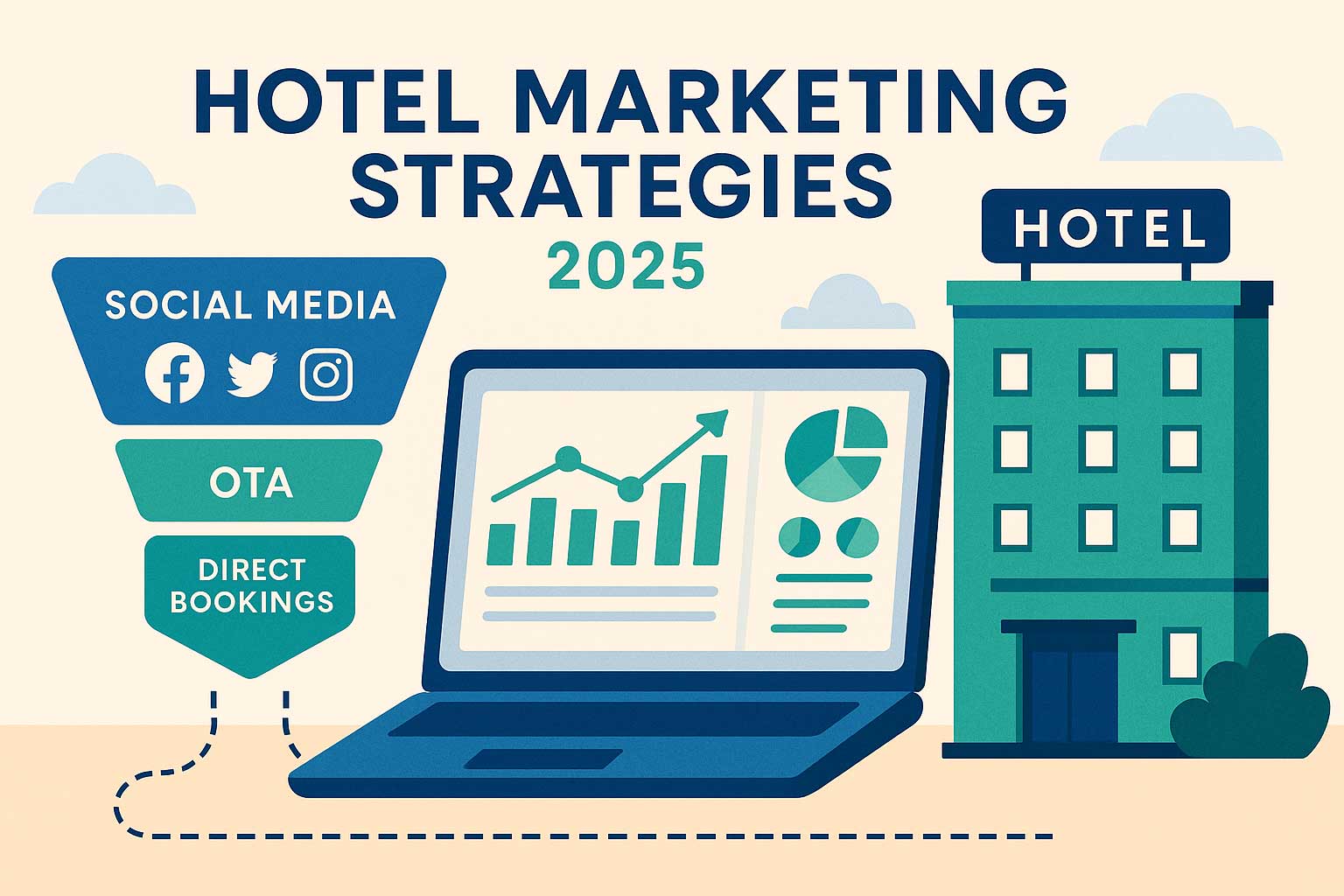Hotel EBITDA: Maximize Profitability in 2025
Sep 1, 2025
 Mika Takahashi
Mika TakahashiPopular Categories
Hotel Technology & InnovationHotel Operations OptimizationDigital MarketingIndustry TrendsRevenue ManagementHospitality Industry
Popular Categories
Trending Post

Hotel Walk Letter Template: Professional Guest Communication

Online Travel Agents: What They Are and How They Work

Hotel Security Systems: Modern Protection Solutions

Hotel Advertising: Complete Guide to Boost Bookings and Revenue

25 Hotel Marketing Strategy Ideas for 2025: Complete Guide

AI Reservation Agent: Revolutionizing Hotel Booking and Guest Experience

PMS Communication: Streamlining Property Management Through Effective Guest Messaging
Table of contents
In the hotel industry, operational efficiency is the key to long-term success. But if you only look at traditional revenue numbers, you might miss the real story behind a hotel’s financial health. While gross operating profit and total revenue give useful information, hotel EBITDA shines a light on the core operations and true profitability potential of a property.
Today, understanding and improving hotel EBITDA is more important than ever for hotel owners, operators, and investors. With rising operating costs, changing guest expectations, and the need to invest wisely in technology, focusing on EBITDA gives you a clear framework for sustainable financial performance.
This guide covers everything you need to know about hotel EBITDA in 2025. From how to calculate it accurately to industry benchmarks and proven strategies used by the top players, you’ll learn how to boost profitability without sacrificing the guest experience.
What is EBITDA in Hotel Management
EBITDA stands for earnings before interest, taxes, depreciation, and amortization. It’s a vital financial metric that measures a hotel’s operating performance before financing and accounting decisions come into play. In hospitality, EBITDA helps you understand how well a hotel is running its core business.
Unlike net income, which can be influenced by things like capital structure or tax strategies, hotel EBITDA cuts through those factors to show the true profitability of a hotel’s main operations. It focuses on earnings from room revenue, food and beverage, and other revenue streams—without being skewed by depreciation on tangible assets or interest on borrowed funds.

But EBITDA isn’t just about measuring profitability. It’s a standardized way to compare how different hotels perform operationally, no matter their ownership, financing, or location. When you’re evaluating multiple properties or considering investments, EBITDA gives you a clearer picture of operational strength than traditional numbers alone.
Industry data shows that hotel EBITDA varies widely. Boutique hotels usually see margins around 16%, while large chains average about 20%. Public hotel companies often trade at around 27 times EBITDA multiples, reflecting how investors trust this metric to gauge long-term profitability.
Tracking EBITDA over time is especially useful. Revenue might spike temporarily thanks to aggressive pricing or promotions, but steady EBITDA growth means real operational improvements that lead to lasting financial success. Focusing on operating costs and efficiency helps pinpoint where hotels can improve profits without hurting guest satisfaction.
How to Calculate Hotel EBITDA: Formula and Real Examples
Calculating hotel EBITDA is straightforward but requires attention to detail. The most common formula starts with net income and adds back interest, taxes, depreciation, and amortization. This way, you isolate the hotel’s operating performance from financing and accounting effects.
Another way to calculate EBITDA is by subtracting operating expenses (excluding depreciation and amortization) from total revenue. This top-down approach can be easier for hotel operators to see where costs impact performance. Both methods, when done right, give you the same result.
Here’s an example from a hotel with $5 million in revenue and these financial figures:
| Financial Component | Amount |
|---|---|
| Total Revenue | $5,000,000 |
| Net Income | $750,000 |
| Interest Expenses | $125,000 |
| Tax Expenses | $200,000 |
| Depreciation | $180,000 |
| Amortization | $45,000 |
Using the standard formula: $750,000 + $125,000 + $200,000 + $180,000 + $45,000 = $1,300,000 EBITDA
To find the EBITDA margin: ($1,300,000 ÷ $5,000,000) × 100 = 26%
A 26% margin is a strong indicator of operational health, placing this hotel in the higher range for its category.
Keep in mind, different types of hotels aim for different EBITDA margins. Economy hotels usually target 15-20%, full-service ones 20-25%, and luxury resorts can reach 25-30% by combining premium pricing with operational efficiency.
By understanding these calculations, hotel owners can track trends and spot whether revenue growth is truly boosting profits or if rising operating costs are eating away at margins.
Hotel Industry EBITDA Benchmarks and Performance Standards
EBITDA margins vary a lot depending on the hotel type, reflecting different cost structures and business models. Economy hotels typically see margins between 12-18%, relying heavily on cost control and operational efficiency to stay profitable despite lower prices.
Midscale hotels aim for 15-22%, balancing costs with better service offerings. They often benefit from economies of scale while keeping expenses in check to meet guest expectations.
Luxury hotels enjoy the highest margins, usually between 18-28%, thanks to premium pricing and investments in operational excellence. They leverage strong brand positioning and guest experience to boost revenue per available room while controlling costs through smart staffing and technology.
| Hotel Category | EBITDA Margin Range | Key Performance Drivers |
|---|---|---|
| Economy | 12-18% | Cost control, operational efficiency |
| Midscale | 15-22% | Balanced service delivery, scale benefits |
| Luxury | 18-28% | Premium pricing, operational excellence |
Location matters too. U.S. hotels average around 19.2% EBITDA margins, helped by mature revenue management systems. European hotels tend to have lower margins, about 16.8%, due to higher costs and labor market differences. Meanwhile, Asia-Pacific properties lead with 21.4% margins, thanks to newer buildings and growing demand.
Seasonality also affects EBITDA. Resorts might see big swings between busy and slow seasons, while business hotels face different patterns tied to corporate travel. Smart hotels plan carefully to keep EBITDA positive year-round.
Post-COVID, the industry saw revenue bounce back, but EBITDA growth per available room was modest—only about 2.5%. That’s because operating costs, especially labor, rose sharply (labor costs up 22.1% since 2019). This highlights the need to focus on efficiency and cost management.
Proven Strategies to Optimize Hotel EBITDA
Improving hotel EBITDA takes a balanced approach—boosting revenue and cutting costs. The best hotels typically see 3-7% margin gains by working on multiple fronts.

Revenue Enhancement Techniques
Hotel dynamic pricing is the backbone of modern revenue management. Hotels using advanced systems often increase revenue by 4-8% compared to fixed pricing, directly boosting EBITDA.
Diversifying revenue streams beyond rooms—through food and beverage, spas, events, and parking—adds profit centers that improve overall hotel profitability. Total Revenue Management can help some hotels double their gross operating profit growth compared to room-only strategies.
Encouraging direct bookings reduces reliance on online travel agencies and their hefty commissions, saving 15-25% on guest acquisition costs. Investing in better websites, loyalty programs, and targeted marketing helps hotels keep more revenue and build lasting guest relationships.
Technology also plays a big role. Automated upselling, dynamic inventory control, and personalized guest services powered by AI can uncover revenue opportunities that manual methods miss.
Hotel Cost Management and Operational Efficiency
Labor costs are often the biggest expense. Since 2019, labor costs have jumped 22.1%, so hotels need smart staffing, cross-training, and automation to stay efficient without cutting service quality.
Energy management programs can cut utility bills by 10-15%. Upgrades like smart building systems, LED lighting, and optimized HVAC save money and improve EBITDA.
Investing in technology automation pays off. For example, a $350,000 AI system investment can generate $855,000 in annual profit improvements by boosting efficiency and guest satisfaction.
Streamlining procurement and consolidating vendors can slash costs by 5-8%, improving terms and reducing admin overhead while maintaining quality.
Strategic Partnerships and Technology Integration
Partnering with tech providers, local businesses, and other hospitality companies can raise EBITDA by 15-25% through shared resources, lower costs, and new revenue streams.
Focusing technology investments on profitability drivers—like automated check-in, smart energy systems, and AI revenue management—helps hotels cut costs and enhance guest experience.
Sustainability efforts are turning EBITDA-positive by 2028. Energy savings, waste reduction, and green sourcing not only cut costs but attract eco-conscious travelers willing to pay more.
Regular audits help spot cost-saving opportunities without hurting guests. Quarterly reviews uncover inefficiencies and redundancies that, when fixed, boost EBITDA steadily.
EBITDA vs Other Critical Hotel KPIs
Looking at hotel EBITDA alongside other KPIs gives a fuller picture of financial health and performance.
EBITDA vs RevPAR and ADR
RevPAR and ADR measure revenue generation, but EBITDA shows how much of that revenue turns into profit. A hotel can have strong RevPAR but weak EBITDA if costs rise faster than revenue.
Sometimes, ADR growth comes with shrinking EBITDA margins because labor costs outpace pricing power. This was common after the pandemic, when revenues recovered but expenses soared.
Finding the right balance between occupancy, pricing, and profitability means watching both revenue and EBITDA closely.
EBITDA vs GOPPAR and TRevPAR
GOPPAR looks at departmental profit, while EBITDA covers the whole property’s operational profit. GOPPAR highlights areas needing attention; EBITDA shows overall efficiency.
TRevPAR includes all revenue streams, while EBITDA shows how well total revenue converts to profit. Hotels with high TRevPAR but low EBITDA often have cost or process inefficiencies.
Different hotel models prioritize different metrics. Management companies might focus on EBITDA to show efficiency; asset-heavy operators may emphasize net operating income and cash flow.
Together, these metrics reveal strengths and weaknesses, guiding where to improve.
EBITDAR vs EBITDA
EBITDA removes interest, taxes, depreciation, and amortization, while EBITDAR goes a step further by also excluding rent and restructuring costs. This makes EBITDAR especially useful when you’re looking at companies with high lease expenses or those undergoing significant restructuring.
Most companies stick with EBITDA unless rent costs make comparisons between similar businesses misleading.
Case Studies: How Major Hotel Chains Maximize EBITDA
Looking at leaders gives insight into smart EBITDA strategies.
Marriott International’s Asset-Light Strategy
Marriott owns less than 1% of its 9,000+ hotels, focusing on management and franchise fees instead. This asset-light model avoids capital expenses and operational risks tied to property ownership while keeping operational control.
In Q3 2024, Marriott reported $1.229 billion in adjusted EBITDA, up 8% year-over-year. This shows how fee-based revenue creates steady returns without property-related cost spikes.
Marriott’s model scales rapidly while improving EBITDA margins by focusing on brand, systems, and revenue optimization rather than real estate management.

Hyatt’s Strategic Repositioning Approach
Hyatt transformed its business by selling $2 billion in real estate and creating long-term management agreements, reducing capital needs and operational complexity.
By 2025, Hyatt aims for 80% of revenue from management and franchise fees, focusing on operational excellence and guest experience to grow EBITDA sustainably.
Hyatt expects $1.085-1.130 billion EBITDA in 2025, a 7-11% increase. This approach cuts real estate risks and lets the company invest in technology and service improvements.
Hotel Industry EBITDA Outlook: 2025-2030 Trends
The next five years will bring big changes for hotel EBITDA.
Technology adoption offers the biggest opportunity, with experts predicting 15-20% operational cost savings by 2030 through automation, AI revenue management, and smart buildings.
Sustainability investments will break even by 2028, cutting costs and attracting guests who value responsible hospitality.
Market consolidation will help big players gain economies of scale, improving EBITDA margins, while independents face more pressure.
| Time Period | Key EBITDA Drivers | Expected Impact |
|---|---|---|
| 2025-2026 | Technology automation, labor optimization | 3-5% margin improvement |
| 2027-2028 | Sustainability ROI, operational efficiency | 2-4% additional improvement |
| 2029-2030 | Market consolidation, scale benefits | 1-3% further optimization |
Asia-Pacific is expected to lead with 3-5% annual EBITDA growth, thanks to newer hotels and rising demand.
Climate adaptation costs will become EBITDA-neutral by 2032 as hotels invest in resilience and save on insurance.
Overall, the industry expects 200-300 basis points of EBITDA margin growth by 2035, driven by technology, efficiency, and smart business models.
Common EBITDA Challenges and Solutions for Hotels
Labor costs are the biggest challenge, rising faster than revenue in many markets. Hotels tackle this with automation, productivity programs, and smart staffing to keep service quality high while controlling expenses.
Insurance and utility inflation pressure margins, so risk management and energy optimization are critical.
EBITDA manipulation risks mean hotels must maintain transparent accounting and clear policies to keep investor trust.
Balancing capital expenditures with EBITDA goals requires careful scheduling, often doing major maintenance in low seasons to minimize impact.
Seasonal cash flow swings call for variable costs, flexible staffing, and revenue diversification to keep EBITDA stable year-round.

Hotels that take a systematic, proactive approach to these challenges protect their EBITDA and stay competitive.
The best hotels see EBITDA challenges as chances to improve, tackling multiple operational areas together for stronger, lasting results.
Key Takeaways for Hotel EBITDA Management
Hotel EBITDA is the go-to indicator of operational health and investment appeal in hospitality. Properties with steady EBITDA growth show operational excellence that drives sustainable advantages and better returns.
Balancing revenue growth with disciplined cost control is the foundation of EBITDA success. Chasing revenue alone without managing costs often leads to short-term wins but long-term pain.
Technology and automation are essential tools for cutting costs and enhancing guest experience, delivering strong ROI.
The shift to asset-light models opens doors for sustainable EBITDA growth by reducing complexity and focusing on operational excellence.
Regular monitoring and benchmarking keep hotels competitive and help spot opportunities quickly.
Understanding EBITDA alongside other key metrics lets hotels manage performance holistically, optimizing profits while delivering great guest experiences.
Top-performing hotels treat EBITDA optimization as an ongoing journey, not a one-time task. This mindset fuels continuous improvement, proactive problem-solving, and lasting success in a competitive market.
